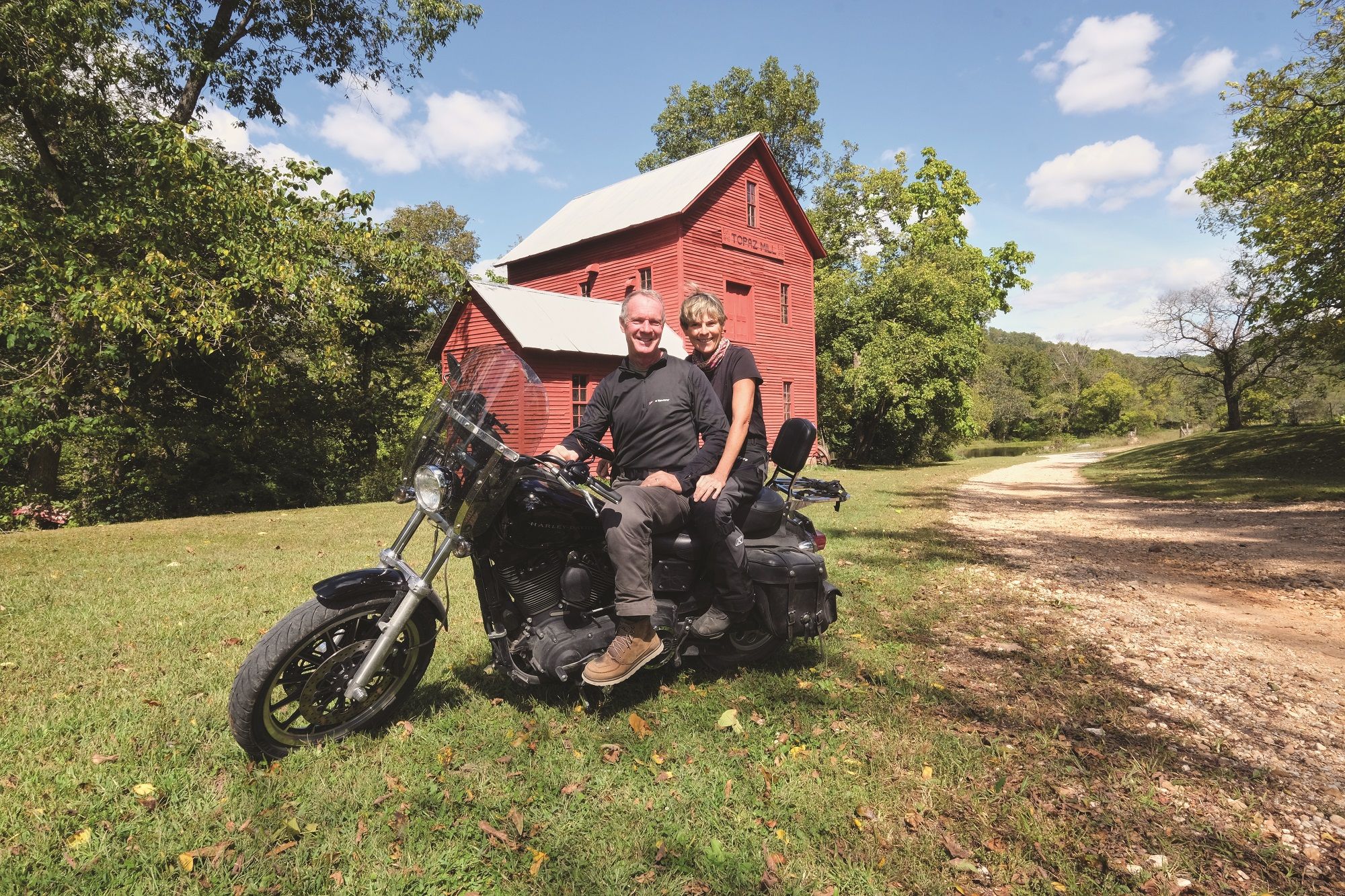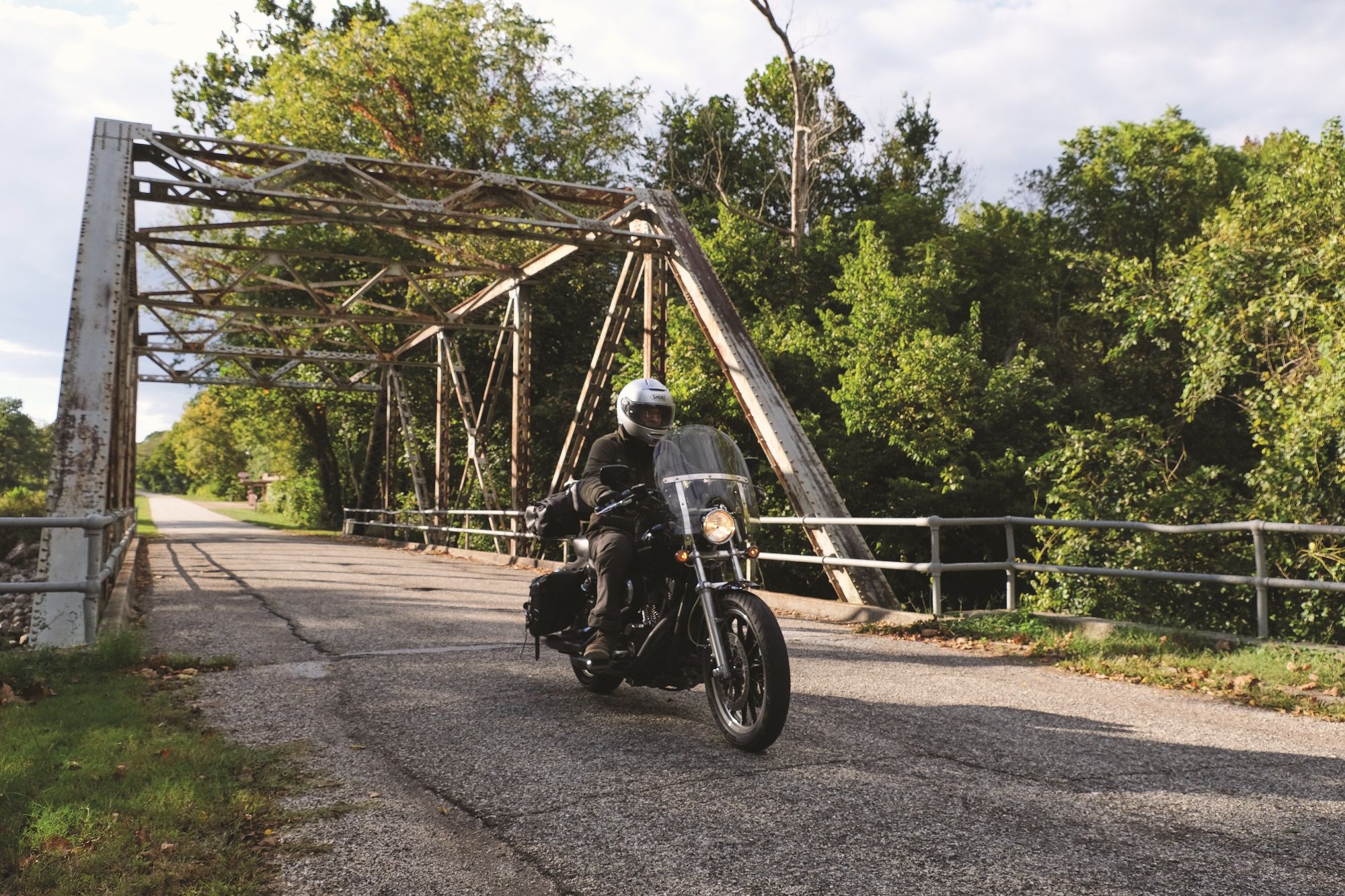Kansas & Missouri

Rolling past the Mid America Dragway near Arkansas City, KS, I felt Bill roll off the throttle of our 2001 Harley-Davidson Super Glide Dyna Sport. The venue was packed and machines were pouring in through the gates. “We should stop and race,” said Bill over the Cardo Packtalk Slim units installed in our helmets. “Wouldn’t it be a great way to commemorate our first date?” I smiled and shook my head in his mirror. “I wish we had the time,” I said and we accelerated back to highway speed. He would have stopped with the slightest encouragement. Our first date was on this very bike, 17 years ago to the day … At the drag races.
Bill shrugged and replied in his typical boyish way: “I had to try.” With the help of Greg Huntsenpiller at Harley-Davidson World in Oklahoma City and our local machine shop, Folks Machine, we had just rejuvenated the bike with significantly enhanced performance. I must admit, I too was tempted to test its limits.

Where It All Began
It was a warm night that late September in 2003, when Bill and I arrived at Thunder Valley Raceway south of Norman, OK. The Harley-Davidson drags were underway, filling the air with the smell of race fuel and the sounds of powerful motors at redline. I watched Bill race the quarter-mile and come ever so close to winning his class. The rest, as they say, is history. We married a year and a half later.
That ride to Thunder Valley Raceway was only the first of many adventures for us, from trekking to Mount Everest Base Camp to hiking China’s Tiger Leaping Gorge and Italy’s Cinque Terre, to exploring the American West and Baja California on both two and four wheels. A few years after we wed, I was browsing the dusty book shelves of a junk store in central Oklahoma when a title caught my eye: I Married Adventure. I thought: “Well, so did I!”
The book, a bestseller published in 1940 and written by Osa Johnson, told the story of two young Kansans—Osa and her husband Martin Johnson—who pursued a lifetime of high adventure in their explorations of then highly exotic spots in Africa and the South Seas. Their groundbreaking films made them celebrities and Osa’s autobiography prompted me to realize that I was not the only one who had married adventure. This week, Bill and I were on our way to visit a museum preserving the Johnson legacy in Osa’s hometown of Chanute, KS.

Not The Kansas of Oz
The Flint Hills offered a pleasing background for our route to Chanute, which, granted, we were pursuing in a roundabout way. While widely renowned and too often ridiculed for its flat terrain, Kansas indeed has hills in its eastern reaches, named for the flint eroded from the bedrock. Some of the last intact tallgrass prairie in North America is also preserved there.
It was lunchtime when we reached Arkansas City (pronounced ar-KAN-sas, since it’s in Kansas), so we stopped for a sandwich at the Steamy Joe Coffee House and Deli, enjoying a cup of their signature brew with chocolate chip cookies for dessert. It was a beautiful, early fall day and we dined on the front porch of the converted bungalow. The Harley-Davidson awaited us within sight, on the grass under a shade tree right in front the building. It was an unofficial parking spot that nobody seemed to mind, including an amiable state trooper who stopped in with a feigned threat of a parking ticket.

Stonehenge, Sow Belly, and the Tallgrass Prairie
After lunch, we picked up the Flint Hills Scenic Byway at Cassoday. It was a pleasant ride through gently rolling hills carpeted with waving, amber grass and the dark green contrast of trees in the vales. The northbound two-lane Hwy 177 took us through the Tallgrass Prairie Preserve and past a Stonehenge-like structure made of railroad ties. The Rail-henge turned out to be part of a walking trail associated with Matfield Station, which formerly served as bunkhouses for railroad workers and now provides Flint Hills lodging for those who want to walk the prairies and watch trains. Some time and 47 miles later we reached the end of the byway at Council Grove, an important stop on the Santa Fe Trail—the famed 19th century trade and emigration route that connected Franklin, MO, with Santa Fe, NM.
It was early evening and daylight was waning as we rolled into Council Grove. We’d made a frustrating error in timing, because the town brims with historic sites and we could take in only a few, including the stump of Post Office Oak. From 1825 to 1847, this massive tree had a cache at its base that served as an informal post office for travelers. The Last Chance Store, built in 1857, provided the final opportunity to buy beans, sow belly, and other supplies before venturing into what were then long miles of wilderness. We like to think of ourselves as adventurers, but we must still marvel at the hardy souls who trod the Santa Fe and other emigrant trails in the 1800s. What challenges they endured!
